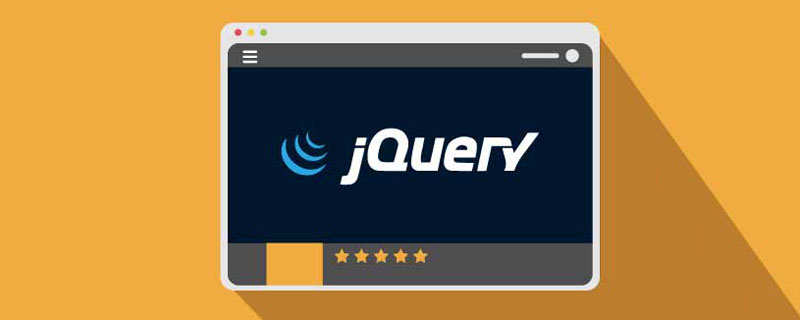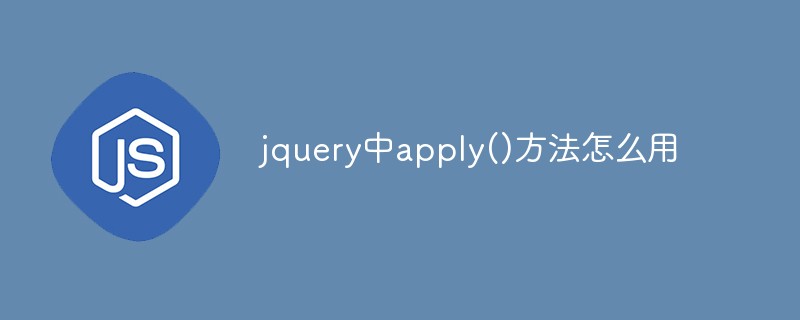The on() method has 4 parameters: 1. The first parameter cannot be omitted, specifying one or more events or namespaces to be added from the selected element; 2. The second parameter can be omitted, Specifies the event handler for the element; 3. The third parameter can be omitted and specifies additional data passed to the function; 4. The fourth parameter can be omitted and specifies the function to be run when the event occurs.

The operating environment of this tutorial: windows7 system, jquery1.10.2 version, Dell G3 computer.
jquery on() method Add one or more event handlers on the selected element and child elements.
Since jQuery version 1.7, the on() method is the new replacement for the bind(), live(), and delegate() methods. This method brings a lot of convenience to the API and is recommended because it simplifies the jQuery code base.
Note: Event handlers added using the on() method apply to current and future elements (such as new elements created by scripts).
jquery on() method accepts 4 parameters
$(selector).on(event,childSelector,data,function)
| Parameters | Description |
|---|---|
| event | Required. Specifies one or more events or namespaces to be added from the selected element. Multiple event values separated by spaces, can also be an array. Must be a valid event. |
| childSelector | Optional. Specifies that event handlers can only be added to specified child elements (and not the selector itself, such as the deprecated delegate() method). |
| data | Optional. Specifies additional data to be passed to the function. |
| function | Optional. Specifies a function to run when an event occurs. |
Example 1: Adding a click event handler to the element
<!DOCTYPE html>
<html>
<head>
<meta charset="utf-8" />
<script src="js/jquery-1.10.2.min.js"></script>
<script>
$(document).ready(function() {
$("p").on("click", function() {
alert("段落被点击了。");
});
});
</script>
</head>
<body>
<p>点击这个段落。</p>
</body>
</html>
Example 2: Add multiple event handlers
<!DOCTYPE html>
<html>
<head>
<meta charset="utf-8" />
<script ></script>
<script>
$(document).ready(function(){
$("p").on("mouseover mouseout",function(){
$("p").toggleClass("intro");
});
});
</script>
<style type="text/css">
.intro {
font-size: 150%;
color: red;
}
</style>
</head>
<body>
<p>将鼠标指针移到这段文字上。</p>
</body>
</html>
Example 3: Add event handlers to future elements
<!DOCTYPE html>
<html>
<head>
<meta charset="utf-8" />
<script src="js/jquery-1.10.2.min.js"></script>
<script>
$(document).ready(function() {
$("div").on("click", "p", function() {
$(this).slideToggle();
});
$("button").click(function() {
$("<p>这是一个新段落。</p>").insertAfter("button");
});
});
</script>
</head>
<body>
<div style="background-color:yellow">
<p>这是一段。</p>
<p>单击任意p元素使其消失。包括本段。</p>
<button>在此按钮后插入一个新的p元素</button>
</div>
</body>
</html>
[Recommended learning: jQuery video tutorial, web front-end video】
The above is the detailed content of jquery on() has several parameters. For more information, please follow other related articles on the PHP Chinese website!
 jquery实现多少秒后隐藏图片Apr 20, 2022 pm 05:33 PM
jquery实现多少秒后隐藏图片Apr 20, 2022 pm 05:33 PM实现方法:1、用“$("img").delay(毫秒数).fadeOut()”语句,delay()设置延迟秒数;2、用“setTimeout(function(){ $("img").hide(); },毫秒值);”语句,通过定时器来延迟。
 axios与jquery的区别是什么Apr 20, 2022 pm 06:18 PM
axios与jquery的区别是什么Apr 20, 2022 pm 06:18 PM区别:1、axios是一个异步请求框架,用于封装底层的XMLHttpRequest,而jquery是一个JavaScript库,只是顺便封装了dom操作;2、axios是基于承诺对象的,可以用承诺对象中的方法,而jquery不基于承诺对象。
 jquery怎么修改min-height样式Apr 20, 2022 pm 12:19 PM
jquery怎么修改min-height样式Apr 20, 2022 pm 12:19 PM修改方法:1、用css()设置新样式,语法“$(元素).css("min-height","新值")”;2、用attr(),通过设置style属性来添加新样式,语法“$(元素).attr("style","min-height:新值")”。
 jquery怎么在body中增加元素Apr 22, 2022 am 11:13 AM
jquery怎么在body中增加元素Apr 22, 2022 am 11:13 AM增加元素的方法:1、用append(),语法“$("body").append(新元素)”,可向body内部的末尾处增加元素;2、用prepend(),语法“$("body").prepend(新元素)”,可向body内部的开始处增加元素。
 jquery怎么删除div内所有子元素Apr 21, 2022 pm 07:08 PM
jquery怎么删除div内所有子元素Apr 21, 2022 pm 07:08 PM删除方法:1、用empty(),语法“$("div").empty();”,可删除所有子节点和内容;2、用children()和remove(),语法“$("div").children().remove();”,只删除子元素,不删除内容。
 jquery中apply()方法怎么用Apr 24, 2022 pm 05:35 PM
jquery中apply()方法怎么用Apr 24, 2022 pm 05:35 PM在jquery中,apply()方法用于改变this指向,使用另一个对象替换当前对象,是应用某一对象的一个方法,语法为“apply(thisobj,[argarray])”;参数argarray表示的是以数组的形式进行传递。
 jquery怎么去掉只读属性Apr 20, 2022 pm 07:55 PM
jquery怎么去掉只读属性Apr 20, 2022 pm 07:55 PM去掉方法:1、用“$(selector).removeAttr("readonly")”语句删除readonly属性;2、用“$(selector).attr("readonly",false)”将readonly属性的值设置为false。
 jquery on()有几个参数Apr 21, 2022 am 11:29 AM
jquery on()有几个参数Apr 21, 2022 am 11:29 AMon()方法有4个参数:1、第一个参数不可省略,规定要从被选元素添加的一个或多个事件或命名空间;2、第二个参数可省略,规定元素的事件处理程序;3、第三个参数可省略,规定传递到函数的额外数据;4、第四个参数可省略,规定当事件发生时运行的函数。


Hot AI Tools

Undresser.AI Undress
AI-powered app for creating realistic nude photos

AI Clothes Remover
Online AI tool for removing clothes from photos.

Undress AI Tool
Undress images for free

Clothoff.io
AI clothes remover

AI Hentai Generator
Generate AI Hentai for free.

Hot Article

Hot Tools

EditPlus Chinese cracked version
Small size, syntax highlighting, does not support code prompt function

MinGW - Minimalist GNU for Windows
This project is in the process of being migrated to osdn.net/projects/mingw, you can continue to follow us there. MinGW: A native Windows port of the GNU Compiler Collection (GCC), freely distributable import libraries and header files for building native Windows applications; includes extensions to the MSVC runtime to support C99 functionality. All MinGW software can run on 64-bit Windows platforms.

SublimeText3 Chinese version
Chinese version, very easy to use

PhpStorm Mac version
The latest (2018.2.1) professional PHP integrated development tool

SublimeText3 Linux new version
SublimeText3 Linux latest version





